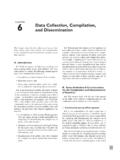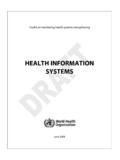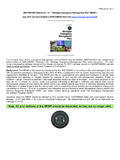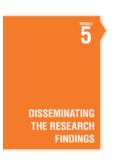Transcription of Cost of Production Statistics - Home | Food and ...
1 1 cost of Production Statistics Guidelines for Data Collection, compilation and dissemination Draft Handbook May 2013 Statistics Division, FAO 2 3 Contents Preface Acknowledgments 1. Purpose 2. Considerations on the survey process and design 3. Detailed guidelines and recommendations 4. Quality assessment 5. compilation of derived indicators and analysis 6. Data dissemination and international reporting 7. Conclusion and main challenges 8. References 9. Appendices 4 Preface Production of agriculture economic performance indicators is a key instrument in economic analysis and a fundamental requirement for effective policy-making. Among these indicators, calculating the cost of Production has historically been one of the most useful of these indicators. Providing users with access to complete and comprehensive Production costs allows all stakeholders with information that will contribute to making markets more efficient.
2 This publication presents recommendations for designing and implementing a program of cost of Production estimation for countries. It takes into account the academic literature which defines the cost of Production concepts and the experiences from statistical agencies that have an ongoing cost of Production program. It acknowledges that not all statistical agencies have the same endowments with respect to its statistical infrastructure and that the target universe varies greatly across countries and makes challenges unique for all countries. Nevertheless, these guidelines serve as a useful reference tool for agriculture statisticians to build a program for estimating commodity cost of Production and for analysts to understand the basics for the estimates. The development of these guidelines has taken into account revised statistical standards and recommendations that include the International Standard Industrial Classification of All Economic Activities (ISIC) , the Central Product Classification (CPC) , and the Global Strategy for Agricultural and Rural Statistics (Global Strategy).
3 In addition to outlining the standard methodology, this publication also provides practical guidance for actual calculation of cost of Production estimates and presents recommended methods for countries to produce high-quality indicators that are also internationally comparable. 5 Acknowledgements This publication draws from or makes direct use of text from a number of sources, in particular the American Agriculture Economics Association s Task Force Report on Commodity Costs and Returns Estimation Handbook and various methodology reports from National Statistical Agencies on cost of Production programs. This manual could not have been completed without the cooperation and input from the members of the Friends of the Chair Expert Working Group formed by the Food and Agriculture Organization of the United Nations. Members contributed time and expertise during all stages of the preparation of this document. The handbook was also the subject of workshops held in 2011 and 2012.
4 The recommendations from these workshops were presented to and approved by the African Commission on Agricultural Statistics (AFCAS) held in 2011 in Ethiopia and by the Asia Pacific Commission on Agricultural Statistics (APCAS) in 2012 held in Vietnam. The Friends of the Chair Expert Working Group members consisted of Ms. Samia Zekaria and Mr. Biratu Yigezu, Ethiopia; Mr. S. Bhavani, India; Mr. Mohammed Kamili, Morocco; Mr. Romeo S. Recide, Philippines; Mr. William McBride, United States; Mr. Adrian Tambler, Uruguay and Mr. Michael Isimmwaa, Zambia. In addition, the work was supported by staff members from the FAO s Statistics Division, notably, Mr. Josef Schmidhuber, Ms. Carola Fabi, Mr. Dominic Ballayan, Mr. Robert Mayo and Mr. Franck Cachia. Peter Lys, a consultant from Canada, wrote the initial draft of this report. The FAO would also like to acknowledge the International Food Policy Research Institute and the Bill and Melinda Gates Foundation for contributing to the financing of this work.
5 6 1. Purpose The Handbook on cost of Production for agricultural commodities sets out to provide national statistical organizations with a how to guide for the Production of cost of Production data. It will recognize the principles laid out in the Global Strategy and will serve to build the statistical capacity for these institutions to augment and improve their agriculture Statistics programs. This Handbook is meant to complement the work already undertaken in the area of national Statistics and as such, does not attempt to replace or supplant this work. The concurrent work underway in other areas of the Global Strategy Action Plan is not the subject of this handbook but nevertheless needs to be considered as integral to the overall system of improved agriculture Statistics base. In particular, items that ought to be considered when applying recommendations with this handbook and taken from the Action Plan include1: The guidelines for statistical laws, confidentiality issues, and the establishment of national Statistics ; Guidelines to meet regional specificities; Statistical legislation to reflect the integration of agriculture into the national statistical system; Technical standards and guidelines to produce Statistics on crop area and yield, livestock and poultry, prices and trade, employment and labor, land use, and fishery and forestry Production ; dissemination standards; Technical standards and guidelines for the coordination of agricultural censuses with population censuses; Guidelines and practices for the development of a master sampling frame; and Guidelines based on good practices and findings of research for sample design.
6 1 Taken from the Global Strategy Action Plan, FAO 2012 7 2. Considerations on the survey process and design Commodity classification and the selection of outputs for data collection cost of Production surveys, as with other agriculture surveys, should respect the international classification system for Agriculture as defined in ISIC Using this definition of the industry leverages the uses of ensuing data collections, allowing estimates to be used in the compilation of agriculture sector accounts, national income and expenditure accounts. Using a consistent classification is the only way to ensure that the statistical agency can obtain estimates for the economy that are complete, unduplicated and comparable internationally. Using ISIC will also ensure that the survey process will be coherent with the integrated survey element of the Global Strategy. The selection of the product or commodity to measure is made according to user needs and uses.
7 In making this decision, one must consider factors such as: Budget; Relative importance of product, measured in quantities or value terms; Any legislative or statutory requirement, such as price support policies; The existence of strategic commodities for food security in the country; and Distribution of Production across the country. No fixed answer can be provided as individual countries are in best position to judge which commodity works best for them. Agriculture and the integrated survey process The Statistical Division of the United Nations has been actively preparing guidelines and recommendations for the conduct of economic surveys. Based on best practices observed from national statistical agencies, these guidelines exist in draft form3 and are subject to adoption by the UN statistical commission. The essence of the guidelines recommends a holistic approach to survey taking. Greatly simplified, the approach recommends that countries design economic surveys that can explicitly be used in the preparation of the national accounts.
8 This in turn 2 its detailed structure can be found at 3 Guidelines on Integrated Economic Statistics , Draft, subject to final editing, Prepared by Friends of the Chair on Integrated Economic Statistics , February 2012 8 means that surveys be designed from start to end with this purpose in mind. Concepts and standards must conform to the end use and that the classification systems that are used are consistent with that purpose. The guidelines suggest the use of a central register of businesses as the sampling frame and several approaches to manage respondent relations. Noteworthy is a suggestion embodied within, that agriculture surveys be folded within the integrated survey system approach. The integrated survey approach is, in turn, a key component within the Global Strategy. Highlights of the integration process as it relates to the collection of agriculture data and with explicit recognition that all countries present unique challenges are as follows: The basis for the integration starts with the sampling frame(s); Population censuses be used to create a register of agricultural and rural households.
9 All households, urban and rural/agricultural be geo-referenced; Remote-sensing products be used to create an area frame if necessary; A register of farms that are above a size threshold and which produce mainly for the markets will need to be established (so-called commercial farms). These are generally specialty farms or those so large that it is difficult to establish a linkage with households; The area frame containing the geo-referenced master household register and the commercial farm register will be the basis for all data collections for use in estimating agricultural Production ; A business register will be established and geo-referenced. The commercial farm register will be a subset. Another subset of this register will be enterprises involved in servicing agriculture, such as storage facilities and firms that process meat, poultry, milk, eggs, cotton, wool and other products; A core set of data requirements will have been established for agriculture and rural Statistics and a set of core data classified for the remaining sectors of its statistical system; Once the core statistical system has been defined, the basic data collections for household and enterprise surveys should be defined; and Official Statistics should be disseminated in a timely manner and made readily available to all data users, including micro-data (respecting country confidentiality requirements).
10 9 Box x Survey design Lessons from the experience of Indonesia Introduction [Complete 10 lines approx.] Description of the survey design [Complete 10 lines approx. Stratification, multi-stage sampling, method of selection of sampling units, etc.] Stand-alone vs. integrated surveys for cost of Production [Complete] Box x Using integrated surveys to collect data on cost of Production : Advantages, drawbacks and challenges Lessons from the experience of Zambia Introduction In Zambia, data on costs of Production is collected and compiled annually on the basis of information gathered from two main sources: - Farm surveys: the Crop Forecasting Survey (CFS) and the Post Harvest Survey (PHS); - Household surveys: Living Conditions Monitoring Survey (LCMS) and Household Budget Surveys (HBS). [Complete if needed 10 lines approx.] Nature of the information collected in each survey [Complete 10 lines approx.] Main advantages of using an integrated approach in Zambia [Complete: advantages in terms of costs (provide information on the costs of each survey if possible), consistency with Production /revenue estimation, frequency of data collection, sample coverage, etc.]

















